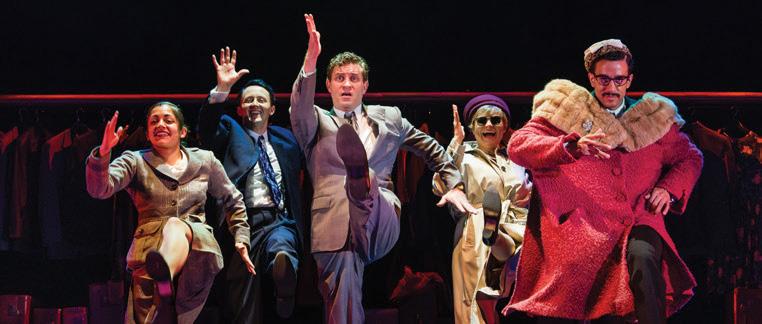

Fall Issue
San Diego International Film Festival
The Haunted Trail of Balboa Park
Temecula Mama’s Pumpkin Drive
featuring
Joan Jacobs Signature Brunch
Carrying forward Joan’s legacy, this first-of-its-kind gathering celebrates resilience, empowerment, and community—inviting us to engage in conversation about the strength we find in ourselves and each other.

Resilience & Renewal
Finding Strength in Every Chapter
A conversation with Julianna Margulies
Brunch Chairs
Elissa Davis • Daryl Gelender • Sally Shaps
Sunday, October 26, 2025
10:00–11:00am: Underwriter Meet & Greet with Julianna
11:00am-1:00pm: Brunch & Conversation
Hyatt Regency La Jolla at Aventine
An Emmy, Golden Globe, and SAG Award-winning actor, bestselling author, and passionate advocate for social change, Julianna is best known for her roles inER and The Good Wife. She uses her platform to champion causes close to her heart, including Holocaust education and women’s empowerment.

www.jfssd.org/Brunch2025







Chabad
Centers o Dieg
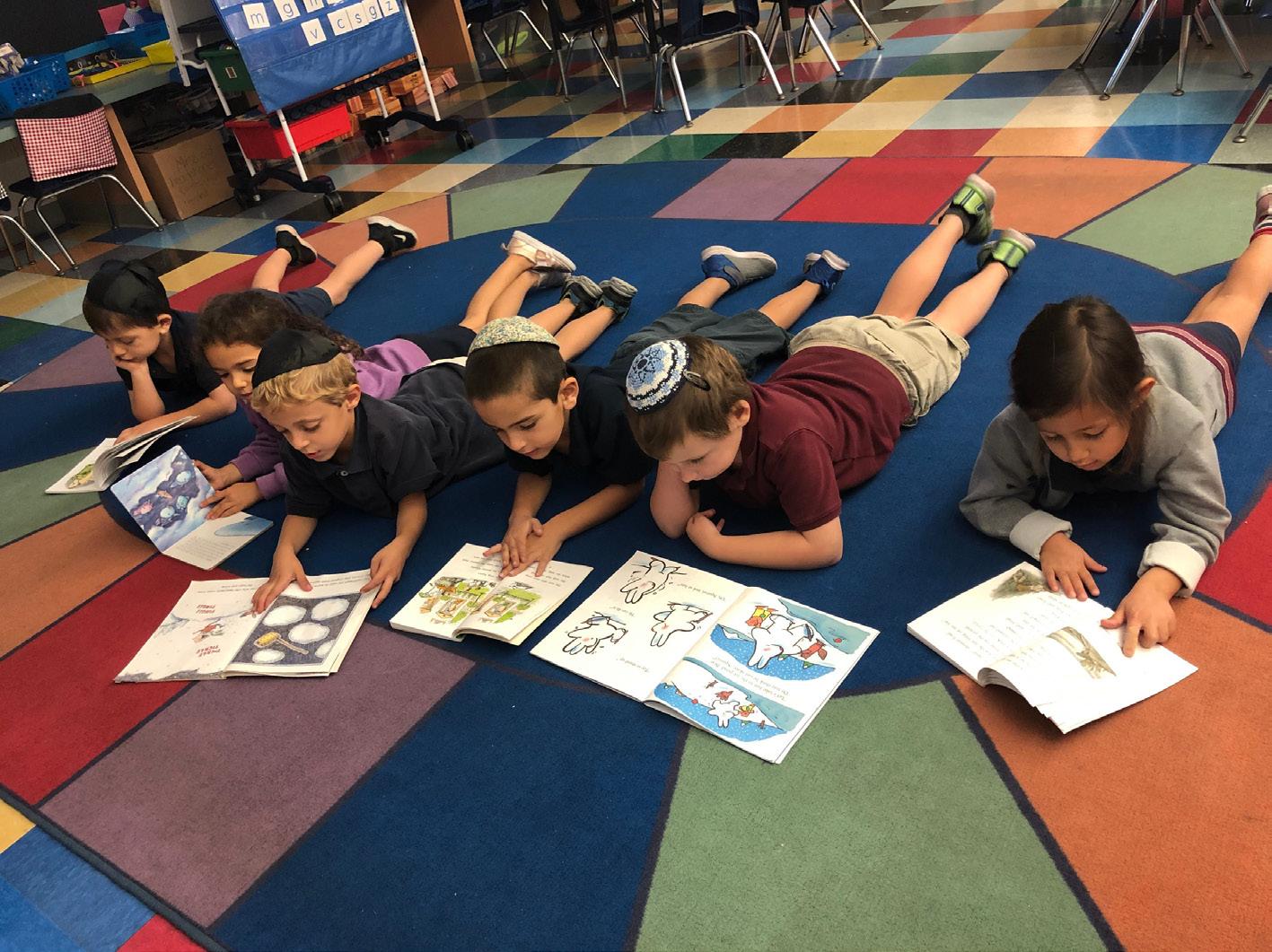


ED-JEW-CATION"
Babies/Kids
Mommy and Me. Hebrew School. C-Kids. Shabbat Programs. Winter Camp.
Teens
Bar/Bat Mitzvah Lessons, C-Teen. JLI Teens. Community Service.
Adults
Torah Portion. Chassidic Philosophy. Kabbalah. Hebrew Reading. JLI. Talmud. We're ALWAYS here for
We have locations all over San Diego! Scripps Ranch (Chabad S. Diego HQ), Bonita, Carlsbad North, Carmel Valley, Chula Vista, Coronado, Downtown, East County, Encinitas, Escondido, La Costa, La Jolla, North County Inland, North Park, Oceanside/Vista, Pacific Beach, Penasquitos, Rancho S. Fe, SDSU, Tierra Santa, UCSD, University City Find your Local Chabad Center and
Move from “Can I retire?” to “How can I make the most of my retirement?” While most people understand the importance of saving for retirement, the concept of retirement income planning may be less familiar. Retirement income planning is a holistic process to help address key retirement decisions, effectively manage risks, and efficiently provide ongoing income to meet both the clients’ current and long-term retirement needs. We can support you by providing the guidance needed to make better, more informed choices to help provide a retirement as flexible as you are. As experienced advisors, we take the time to understand your unique goals to help create a plan tailored for you – one that will modify and change over time.




PUBLISHERS
Mark Edelstein and Dr. Mark Moss
EDITOR
Susan Edelstein
ASSISTANT EDITOR
Makayla Hoppe
CREATIVE DIRECTOR
Donna D’Angelo
ARTS & ENTERTAINMENT EDITOR
Eileen Sondak
CONTRIBUTING WRITERS
Emily Bartell, Linda Bennett, Andrea Simantov, Trevor James McNeil, Marnie Macauley, Rabbi Yeruchem Eilfort, Galia Miller Sprung, Micah Siva Lisa McGuigan
CONTRIBUTING ILLUSTRATOR Pepe Fainberg
ADVERTISING REPRESENTATIVES Alan Moss | Palm Springs
EDITORIAL editor@sdjewishjournal.com
ADVERTISING marke@sdjewishjournal.com
CIRCULATION & SUBSCRIPTIONS ronniew@sdjewishjournal.com
ART DEPARTMENT art@sdjewishjournal.com
LISTINGS & CALENDAR assistant@sdjewishjournal.com
SDJJ is published monthly by San Diego Jewish Journal, LLC. Subscription rate is $24 for one year (12 issues). Send subscription requests to SDJJ, 122 15th Street, PO Box 421, Del Mar Ca 92014. The San Diego Jewish Journal is a free and open forum for the expression of opinions. The opinions expressed herein are solely the opinion of the author and in no way reflect the opinions of the publishers, staff or advertisers. The San Diego Jewish Journal is not responsible for the accuracy of any and all information within advertisements. The San Diego Jewish Journal reserves the right to edit all submitted materials, including press releases, letters to the editor, articles and calendar listings for brevity and clarity. The Journal is not legally responsible for the accuracy of calendar or directory listings, nor is it responsible for possible postponements, cancellations or changes in venue. Manuscripts, letters, documents and photographs sent to the Journal become the physical property of the publication, which is not responsible for the return or loss of such material. All contents ©2025 by San Diego Jewish Journal. The San Diego Jewish Journal is a member of the American Jewish Press Association and the Jewish Telegraphic Agency.
San Diego Jewish Journal (858) 442 9922
#SDJewishJournal SanDiegoJewishJournal sdjewishjournal.com



Support the Jacobs & Cushman San Diego Food Bank through an IRA charitable rollover and help nourish San Diegans in need.
If you’re age 70½ or older, you can use your Individual Retirement Account (IRA) to make a meaningful gift to the San Diego Food Bank, while potentially reducing your taxable income.
With an IRA Charitable Rollover, You Can:
• Avoid taxes on transfers up to $108,000
• Satisfy some or all of your required minimum distribution
• Reduce taxable income, even if you don’t itemize deductions
• Make a gift not subject to charitable deduction limits
• Use your rollover to fulfill an existing pledge

Create your legacy today. Visit sdfblegacy.org or scan the QR code to learn more about IRA charitable rollovers and other planned giving options.

Fighting Hunger. Feeding Hope. Learn about more ways to support the San Diego Food Bank SanDiegoFoodBank.org


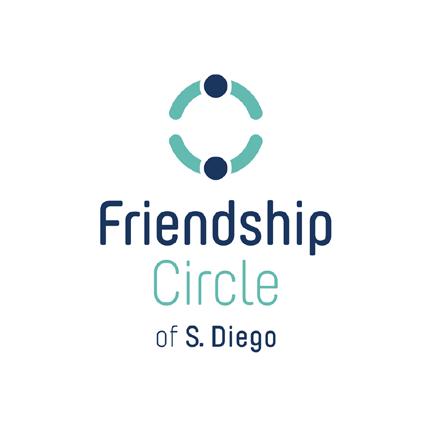

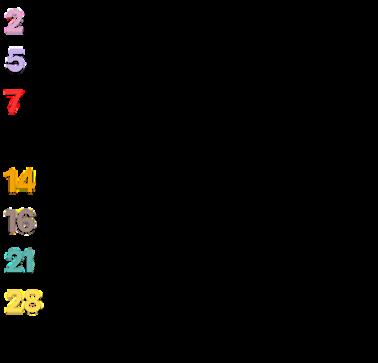


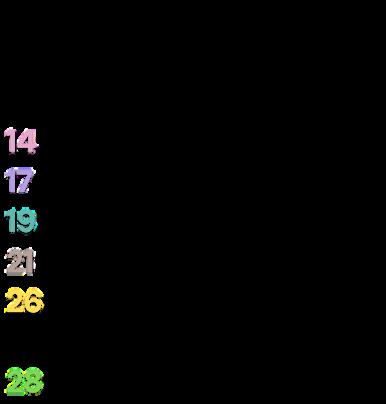




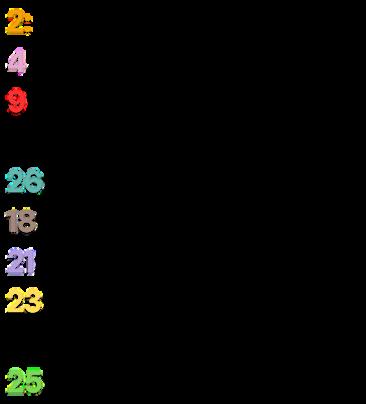









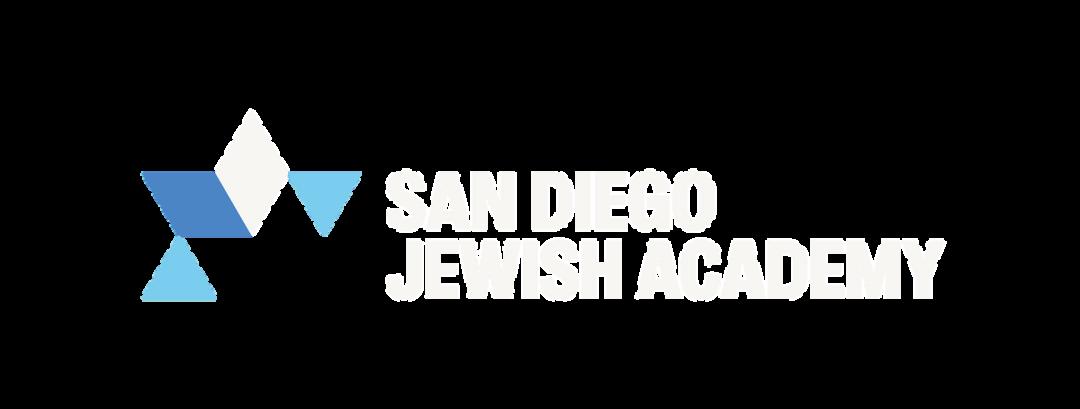























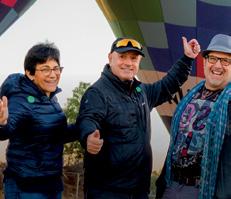








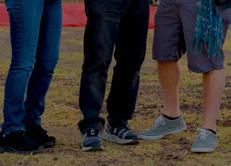



SUSAN EDELSTEIN
Let Fall Begin
Fall officially began on Sept. 22 with the Fall Equinox, when day and night are in perfect balance, when we reflect on and give thanks for that balance and honor life’s cycles. Traditionally, Fall is a time to harvest the last crops, enjoy the bounty, connect with nature and celebrate with our families and in our communities. For many, Fall is a favorite time of year. It brings shorter days, cooler weather and many annual events and festivals.
Of course, now, Oct. 7 has become a part of Fall, but if Israelis can welcome and celebrate this time of year, so can we. Andrea Simantov relates that contrary to the images we see daily, life in Israel is “vibrant, elegant and passionate,” and reflection and a desire to be even better tomorrow are hallmarks of Jewish culture. Galia Sprung says that for her, October used to be a good month, and now, after two years of war, she is taking it back. Her focus will be on friends, family and the World Series because “there is nothing like the crack of the bat on a homerun pitch to revive the spirit.”
Rabbi Eilfort reminds us that following Rosh Hashanah and Yom Kippur and our positive resolutions, it is time to observe Sukkot, literally Our Time of Joy, when we build sukkahs and share meals outside and extend our hospitality. Micah Siva offers her Dilly Rice Cabbage Rolls as a perfect recipe for Sukkot which is a “harvest holiday and the time to share a meal with neighbors under the stars.” And it’s the perfect time of year for Marnie Macauley’s strategic resolutions and life lessons which can be summed up as ‘talk less, listen more.’ As this is a time of reflection and gratitude, some people put their thoughts on paper —in journals, letters and family anecdotes. Trevor McNeil tells us about Sydney Taylor, whose stories about life in her ‘large, quirky Jewish family’ led to an award-winning career in children’s literature.
Our October issue features several annual Fall events, like the San Diego International Film Festival which was established in 2001 and occurs over the course of five days in various locations including outdoors. This festival “continues to grow in size and influence with films that inform, inspire and entertain.”
Of course, October is the time for Halloween, a thousand-year tradition commemorating the passing of the dead and associated with spooky costumes, pumpkin carvings, and the thrill and horror of the other-wordly. The Haunted Trail in Balboa Park has become a San Diego Halloween tradition and is in the top five scariest Halloween experiences in the whole country. The Trail is now in its 26th year, and if you have not yet been, maybe this year you’ll dare. And if you’d like to do something wonderful with your leftover pumpkins, Temecula Mama’s annual pumpkin drive is the perfect opportunity.
Wishing you a peaceful October and a bounteous Fall. A
Our Town
BY LINDA BENNETT & EMILY BARTELL

The Center for Jewish Culture (CJC) kicked off its 2025-26 Season at the Lawrence Family JCC on Aug. 21. Tony Award-winning producer Jeffrey Seller sat down for a conversation with The Old Globe Erna Finci Viterbi Artistic Director Barry Edelstein to discuss his new book, “Theater Kid: A Broadway Memoir.” What a thoroughly entertaining evening. Seller, the driving force behind Broadway’s “Hamilton,” “Rent,” “Avenue Q” and “In The Heights,” treated us to a fabulous evening of behind-the-scenes stories and insights into musical theater and Broadway. Some of those also on hand for this enjoyable evening were Judi Gottschalk, Al Sheldon, David Gimbel, Lori Sherer, Jackie Gmach, Nancy and Alan Spector, Jane Fantel, Sylvia and David Geffen, Robin Rubin, Margie Mopper, Jill Stone, Ruthie Warburg, Sonia Israel, Rebecca and Wayne Levin, Anna Kemp and Shira Levy
On Sept. 10, we were back at the Lawrence Family Jewish Community Center for “An Evening with Dennis Ross.” Former Ambassador Ross, veteran U.S. diplomat and expert in Middle East policy, came to discuss his brand-new book, “Statecraft 2.0: What America Needs to Lead in a Multipolar World.” From the White House to the Middle East, Ambassador Ross has been at the center of American diplomacy for decades. In this conversation moderated by Miri Belsky of The Washington Institute, Ross explained revisions needed in U.S. foreign policy due to rising challenges at both global and regional levels. A very interesting and insightful program, some of the folks in the crowd were Eileen Wingard, Marty Kransberger, Josh Feder, Ron Mandelbaum, Debra Feldstein, Hillary and Jeff Liber, Michael Flaster, Hannah Cohen and Elliott Edelstein, Fran and Burt Israel, Laurie and Larry Cooper, Nancy and Marty Goldberg, Byrne and Dick Eger, and Stacie Bresler-Reinstein
The 211 Club Seacrest Annual Patron Party was held on Aug. 24. Hosted by the Seacrest Foundation, the event honored its members known as “Visionaries of Jewish Eldercare” who support Seacrest Village Retirement Communities and Seacrest at Home, ensuring a high quality of life for frail seniors. Celebrating another successful year, the evening was absolutely lovely. Held at the beautiful home of Jeffrey and Mayo Strauss in Solana Beach, with stunning sunset views and dinner under the stars, Dr. Laurie Greenberg addressed the 150 attendees in gratitude for their commitment to aiding seniors residing at Seacrest Village or those receiving assistance from Seacrest at Home. Some of those enjoying the evening along with us were Myrna Wosk, Sue and Hal Small, Rosalee Kitaen and Steve Sokolic, Linda and Larry Okmin, Gayle Wise, Janice and Steve Boner, Judy Adler, Howard Bolotin, Marty Ehrlich, Andrea and Ira Feinswog, Inga Feinswog, and Janet and Wil Gorrie
Mazel Tov to William and Jean Seager of Coronado on the occasion of their grandchild, Aaron Asch, becoming a Bar Mitzvah in Maine. Aaron, the youngest of three children, is the son of Rabbi Erica Asch and Chris Myers Asch. Rabbi Asch, who was raised in Coronado, is a past President of CCAR (Central Conference of American Rabbis).
Mazel Tov to Leah Copans on becoming a Bat Mitzvah at Temple EmanuEl on Aug. 16. Happy parents, Keri and Shaun Copans along with older sibling, Hayley, were overjoyed. Leah’s grandparents are Avrille and Harold (z”l) Copans
Mazel Tov to Sam Rosen Schwartz on becoming a Bar Mitzvah on Aug. 9 in Atlanta, Georgia. Happy parents, Amy and Larry Schwartz along with
grandparents, Rimma and Jay Rosenberg, Linda Chavis and Barry Schwartz are over the moon with joy.
Heads Up! On Sunday, Oct. 26, beginning at 8:00 a.m., the House of Israel in Balboa Park will hold the Walk B’Yachad, a walk to support mental health for Israelis and the Jewish community.Come walk to raise awareness and critical funds for youth mental health in Israel. The event is hosted by American Friends of ELEM, Israel’s leading nonprofit organization committed to supporting at-risk youth across the country, including those facing homelessness, abuse, neglect and other crises.
Yom Huledets Sameach to...
Saul Snyder celebrating his 93rd birthday. Tito Salzmann celebrating his 84th birthday.
CELEBRATING
Wedding Anniversaries
with infinite love & happiness, Mazel Tov to…
Marjorie and Sanford Schane, 65 years.
Jane and Herbert Lazerow, 62 years.
Linda and Louis Levy, 59 years.
Hollis and Alan Litrownik, 58 years.
Linda and David Bachrach, 56 years.
Judy and Harvey Amster, 55 years.
Julie and Mitchell Dubick, 51 years.
Deborah Horwitz and Paul Nierman, 51 years.





Proven Montessori Method and Philosophy
Bilingual Program: English & Spanish
Learning through hands-on experience
Integrated secular and Judaic curriculum
Skilled teachers, trained in early childhood development
Secured, state-of-the-art facilities

News & Notes
COMPILED BY SUSAN EDELSTEIN

After Charlie Kirk is Fatally Shot in Utah, Jewish and Israeli Leaders Call for Prayers and End to Political Violence
Turning Point USA Founder Had Been an Outspoken Supporter of Israel.
by Asaf Elia-Shalev, JTA News
Israeli and pro-Israeli U.S. Jews were among those expressing concern after Charlie Kirk, the 31-year-old conservative activist who founded Turning Point USA and emerged as a leading voice of the pro-Trump right, was shot during an appearance in Utah.
Prominent politicians from both political parties quickly condemned the violence. President Donald Trump, who has counted Kirk as one of his most loyal surrogates, called him “a great guy.” California gov. Gavin Newsom posted on X, “The attack on Charlie Kirk is disgusting, vile and reprehensible. In the United States
of America, we must reject political violence in EVERY form.”
Israeli leaders and Jewish activists, some of whom have developed relationships with Kirk through his pro-Israel activism, also reacted with alarm. Israeli Prime Minister Benjamin Netanyahu posted on X: “Praying for @charliekirk11.”
Kirk’s Turning Point USA has maintained ties with pro-Israel organizations and regularly hosts pro-Israel speakers at its conferences. Kirk himself had traveled to Israel and praised Trump’s policies there, including the 2018 U.S. embassy move to Jerusalem.

Meet Jack Klein: SDJA student patent-holder
Jack Klein, a senior at San Diego Jewish Academy, has been awarded a U.S. utility patent for his original invention: a vacuum-sealing food preservation system designed to reduce waste and keep food fresher longer.
The idea struck Klein in a moment of frustration, while searching his pantry for a way to preserve a half-eaten bag of chips. That led him to develop the concept in his “Ideas to Products” class at SDJA, and continue building it through the school’s Lions Lab business incubator.
Jack’s invention has grown into a fully patented product. His journey reflects his persistence, curiosity and entrepreneurial spirit. Klein said, “I learned that persistence matters even more than the idea itself.”
A patented inventor at 16, Klein hopes to continue developing products that make a difference and is planning to pursue business and entrepreneurship in college.
Charlie Kirk debates with students at The Cambridge Union in Cambridge, Cambridgeshire, England. Photo: Nordin Catic/ Getty Images for The Cambridge Union
Take it from this Rabbi: You should binge -watch Netflix’s ‘Long Story Short’ for the High Holidays
by Rabbi Benjamin Resnick, JTA News
During Selichot services, I led members of our congregation in our first recitation of “Ashamnu,” the confessional acrostic that we accompany by striking our hearts.
And then I went home, still humming “Ashamnu,” and something rather incredible happened. I turned on Netflix and there they were again: “Ashamnu,” Selichot and the extraordinary drama of the High Holidays, as I have never before seen them depicted in anything remotely mainstream.
“Long Story Short,” Raphael BobWaksberg’s animated series about a Jewish family, is letter-perfectly accurate, loving and profound. It was astonishing.

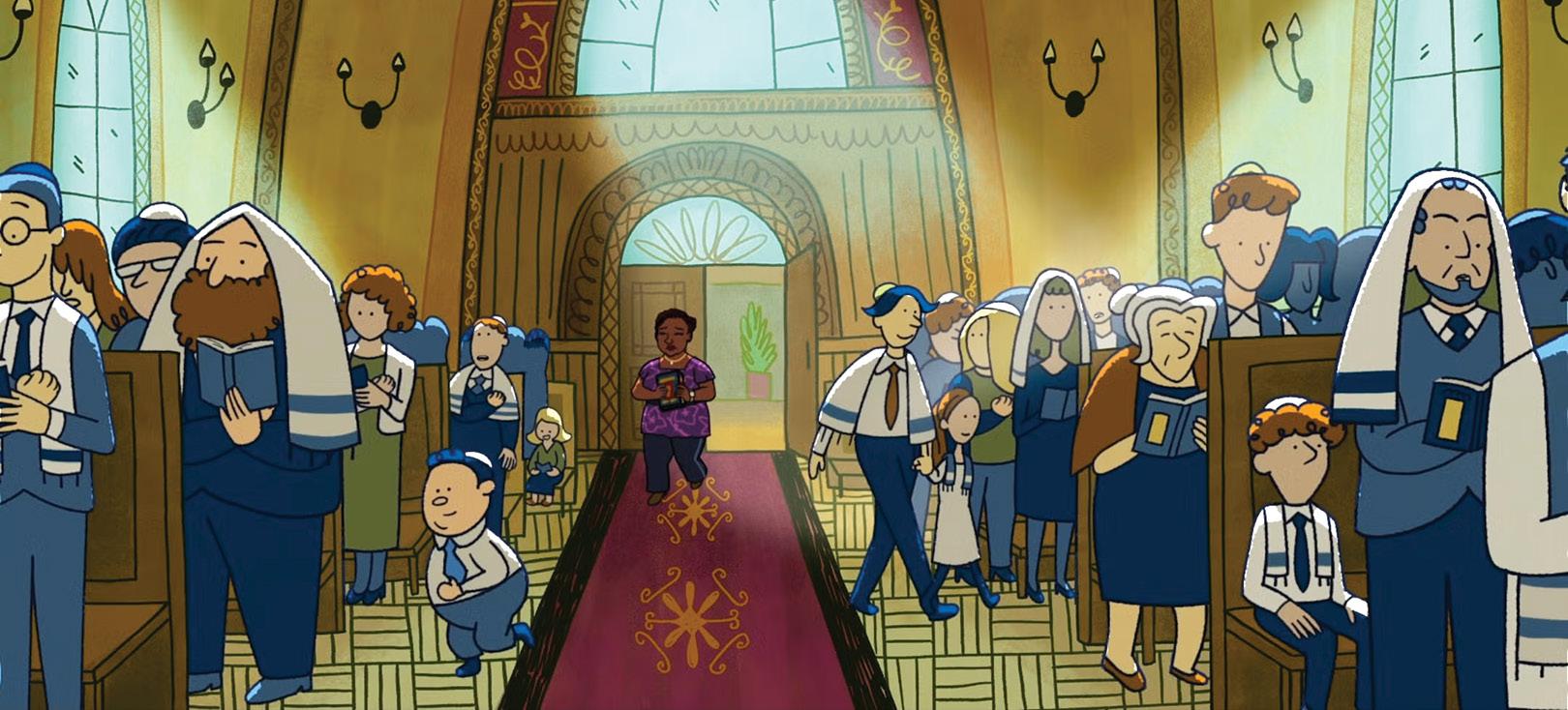
It is certainly the most Jewish television show airing right now on any mainstream platform and also, very likely, among the most authentic pieces of Jewish American narrative art in the 21st century. And it is very funny.
Despite all the laudable effort towards diversifying the kinds of American stories we tell, I have never seen a show that depicts a Jewish American reality that is recognizable to me — hilarious, unabridged, profound and reverent. Until now.
Oct. 7 Documentary Briefly Axed from Lineup Wins Toronto Film Festival’s People’s Choice Award
by Philissa Cramer, JTA News
A documentary about a dramatic rescue in Israel on Oct. 7, 2023, won an audience award at the Toronto International Film Festival, one month after it was reinstated to the lineup after a brief cancellation.
“The Road Between Us: The Ultimate Rescue” tells the story of retired IDF general Noam Tibon’s mission to rescue his family during Hamas’
attack on Kibbutz Nahal Oz. Tibon killed Hamas terrorists and saved other Israelis while driving from Tel Aviv to the kibbutz near Gaza after concluding that the army could not be relied upon to save his son and his family.
The movie is expected to play in about 20 cities in the United States beginning in late October.
Courtesy NetFlix.
Photo: Harold Feng/Getty Images.
LIVING ON THE FRONT PAGE
by Andrea Simantov | andreasimantov@gmail.com
The Only Shelter
My friend, Timna, and I were sharing a cup of coffee early this morning when she said, “If it weren’t for my work, I wouldn’t leave Israel.” I concurred. This month I’m scheduled to fly to Maryland for a short visit with my elderly mother. “If it weren’t for my Mom, I wouldn’t leave the country. Not ever.” Timna is proudly secular; I am Torah observant. But despite religious differences, we share the same desire to remain in Israel, tethered to one another by our mutual Zionist beliefs.
These sentiments may sound strange to Jews and non-Jews living in the Diaspora who are still getting their Middle East news from sources that are not in our corner, including The Washington Post, Al Jazeera, The New York Times, BBC and CNN. When friends ask me how my family and I are holding up during wartime, I have to tread lightly and not mention my recent manicure, cleaning lady issues, the newest brasseries and what is playing in both the cinema and Shakespeare Company. Life doesn’t just ‘go on’ here. It is vibrant, elegant, passionate and rife with meaning. Not exactly the image that splashes across the Western screen.
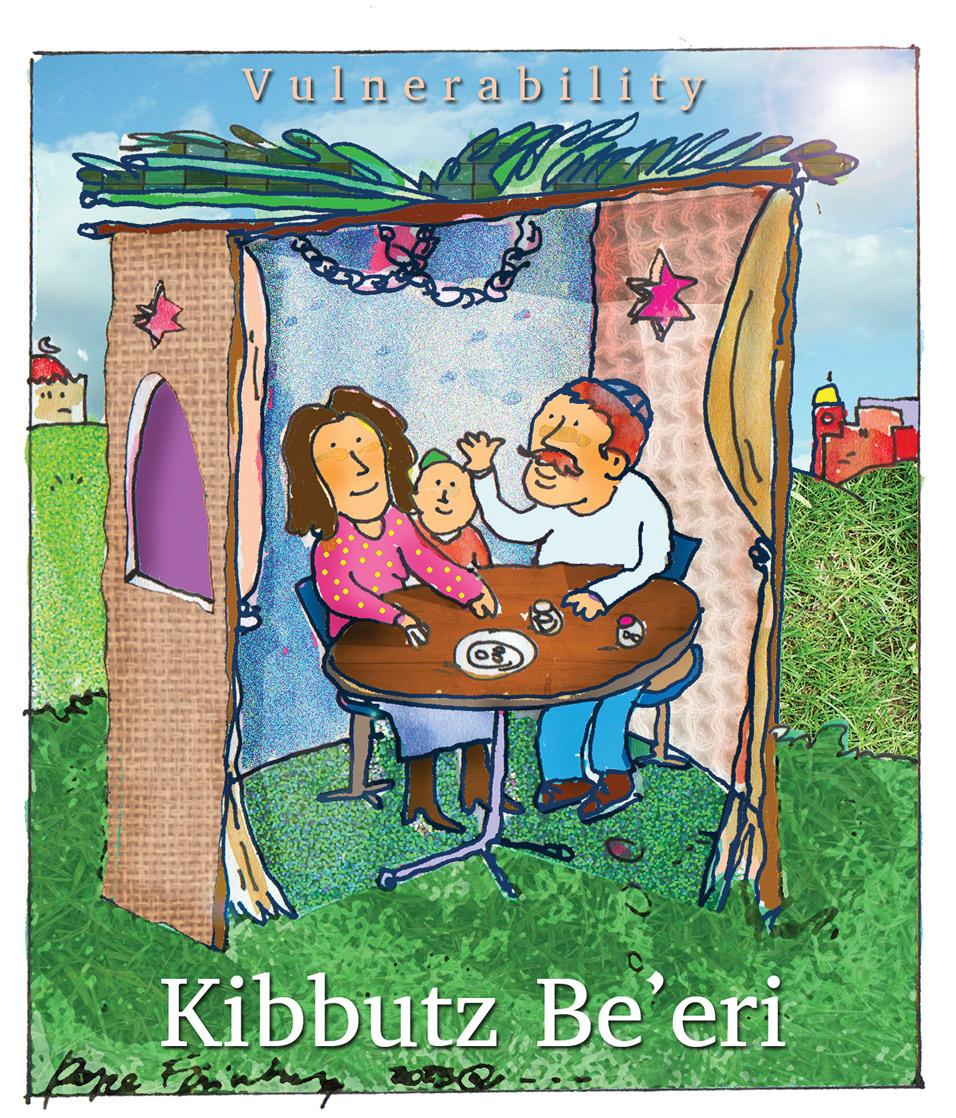
endless cycle of sirens that can make an entire nation jumpy and frightened. But there is a general consensus that we know what to be frightened of, we know who our enemies are, we know that we have no other country and we know that, as Jews, we are safest here where we know we belong.
a coward. Israelis have been cured of the aforementioned syndromes by virtue of being universally distrusted and even loathed. There is a strange comfort in not having to prove that you’re really a ‘good guy.’
On Oct. 7, 2023, fortified safe rooms, bomb shelters, kibbutz fences and dance-party security gates proved themselves to be nothing more than houses of cards. We are still working out the lessons from that morning. Subsequent observations, rationales, blaming and shaming have already engulfed our national psyche and, because we are Jewish, we will never, ever let it go. Good. Humility, reflection and a desire to be even better tomorrow — and the day after that — are hallmarks of our glorious people.
But back to vulnerability: A sukkah is neither ‘cute’ nor an obscure, ancient custom that no one takes seriously any more. Au contraire, mon frere! Sukkot is so much more than my favorite holiday.
And yet we are truly fighting for our very existence. It is no wonder Israelis have such short fuses. Employment uncertainty, PTSD in every sector, an
Any moral person who does not believe that he is vulnerable to the rage of those who believe differently than him is either deeply enmeshed in wish-think (wishing things were different and hoping that “wishing the bad away” will magically work out in the end) or delusional, lazy and
A critical lesson emerges when erecting a fragile hut in one’s garden, parking lot or large/small balcony. Especially for those of us who live in a climate that grows colder with the advent of winter, we step outside and physicalize our faith. Not merely ‘talk’ about it. Not merely ‘learn’ about it. We perform the mitzvah of dwelling in a sukkah with our entire body and,
continues on page 19 >>

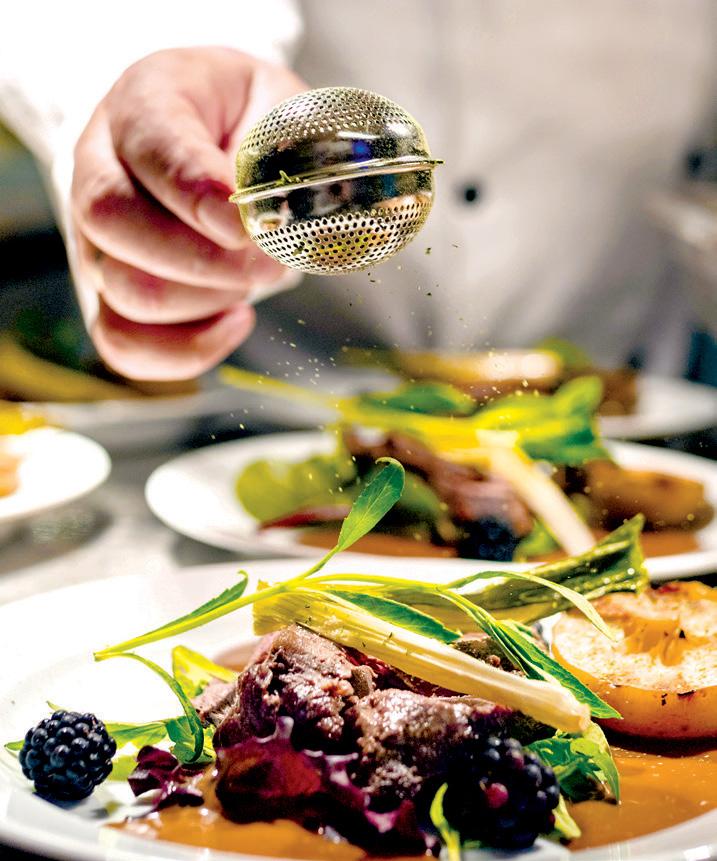






WRITTEN IN FIRE
by Trevor James McNeil tremcneil1980@gmail.com
Not Just Child’s Play
It is often said that if you want to change things, you have to reach the young. Paradoxically, children’s fiction is often dismissed as frivolous or not as good as ‘serious’ adult writing, mostly because it is erroneously assumed that work for children needs to be ‘dumbed down’ when really, kids have more total brain cells and faster brain function than adults. Someone who seemed to really understand this was author Sydney Taylor.
Born in New York to recent JewishGerman immigrants in 1904, Taylor was always clear in her intentions, if not always considered in her actions, and contradictions didn’t seem to bother her. Such as when she left high school at age 16 to take business classes at night, only to join the Young People’s Socialist League three years later where she met her husband. It was more of a social conscience than political fervor that drove her to join the Socialist League, and she would go on to attend the Rand School of Social Science in her 20s.
Her affinity for children showed fairly early with her summer job as a camp counselor when she was a teen. The kids grew so close to her that she came to be known as “Aunt Syd.” The feeling was apparently mutual, and she started writing stories based on her life in her large and quirky Jewish family. Finally, in 1950, Taylor’s husband submitted a collection of her stories to a children’s literature contest put on
It was more of a social conscience than political fervor that drove her [Sydney Taylor] to join the Socialist League...
by the publishing company Wilcox & Follett. Taylor won and was awarded the second-ever Charles W. Follett Award in Children’s Literature. The prize included a publishing contract with Wilcox & Follett. Taylor’s first book, “All-of-a-Kind Family,” was published in 1951.
More by context than intent, “Allof-a-Kind Family” was one of the very first books directed to children that was explicitly about Jewish children, certainly in the North American context, where children’s literature itself was still a relatively new concept, only really popularizing about 90 years before. Despite this milestone for the form, both early promotion and reviews for the book conspicuously omitted the word “Jewish.” Despite the low-key
antisemitism of the time, partly based on lingering soreness from the war, the book was a hit with Child Life magazine naming “All-of-a-Kind Family” as one of the 10 best children’s books of 1951.
Encouraged by the book’s success, Taylor immediately submitted another manuscript to Wilcox & Follett. The excitement was dampened when her editor, who had worked on “All-of-aKind Family,” suggested that she retract the submission, saying that the second book could ruin her career. Discouraged but undaunted, Taylor switched track and started writing for teenagers. There was the potential for her to be a protoJudy Blume, but it was not to be, as both her book and magazine submissions were rejected, and the same editor advised her against writing for the teen market. Given the success of “All-of-aKind Family” it was unlikely to have been the quality of the writing that caused so many editors to take pause, but Taylor took it on the chin.
Returning to the well, her next published book was “More All-of-a-Kind Family,” which came out in 1954 with illustrations by Mary Stevens. Finding her groove within the children’s market, Taylor’s third effort,” All-of-a-Kind Family Uptown,” came out in 1958 with relatively little resistance or controversy, the illustrations again done by Mary Stevens, who was helping to define the family in the public imagination.
continues on next page
Literature
continued
Technically, “All-of-a-Kind Family Downtown” was meant to come out third but did not come out until 1972, partly because of the inclusion of some tough but accurate truths about city life, including poverty and hunger. Taylor had to wait until her original editor at Wilcox & Follett retired to get the book published.
On a fairly regular schedule, Taylor’s next book, and the first outside the “All-of-a-Kind” series, “Mr. Barney’s Beard,” was published in 1961 with illustrations by Charles Geer. While it was a bit of a departure from the “All-ofa-Kind” series, “Mr. Barney’s Beard” was a success and is still preserved and archived today. An interesting bit of absurdism, the book relates the tale of the titular Mr. Barney, a very lazy fellow who has a very long and impressive beard because he refuses to shave, considering it too much bother, a line he sticks to even after a bird nests in his beard.
On a roll, Taylor then published “Now That You Are 8” in 1963, illustrated by Ingrid Fetz. Sticking to what she knows, Taylor wrote “Now That You Are 8” as a collection of stories about eight-year-old Ella as she grows up in the Bronx with her Jewish family in the early 20th century, much as Taylor had.
Perhaps her most famous work, “The Dog Who Came to Dinner,” published in 1966 with illustrations by John E. Johnson, is a biting satire targeting assumptions and keeping up appearances. It takes place at a fancy dinner party that gets crashed by a large, untrained dog that the guests assume must belong to the family, leading to almost Edward Gorey-level shenanigans.
Also published in 1966 with illustrations by George Porter, “A Papa Like Everyone Else” takes a sadder turn, based on stories a Hungarian friend told Taylor as her friend was dying of cancer. It was also the last of her books to be published in her lifetime, aside from the 1972 publication of “All-of-a-Kind Family Downtown.”
Critical reception largely soured by the end of Taylor’s career and her last books, including the posthumous “Ella of All-of-a-Kind Family” published in 1978 with illustrations by Gail Owens, and “Danny Loves a Holiday” illustrated by Owens and published in 1980, got lukewarm reviews, often from the same outlets that once fawned over her earlier “All-of-a-Kind Family” books. Taylor died from cancer in 1978 at the age of 73. A
Growing up in the far north, Trevor James McNeil had little to do other than read when the temperature went below 40 Celsius, and he developed an affinity for stories of all sorts. Graduating from the University of Victoria in 2009, he has been reading and writing in a professional capacity since. He lives in a cabin in the woods with his dog, and firmly believes The Smiths would have been better as a trio.
Israeli Lifestyle
continued
consequently, demonstrate that we know Who is in charge. Not the architects and designers of exquisite high-rise buildings or mansions by the sea. Those who believe that nuclear weapons, coiled barbed wire and barking dogs provide better protection than a sukkah are forever destined to beseech other men — flesh, blood, fragmented and flawed — for deliverance. In cultivating an awareness that Heaven ensures ultimate salvation, we believers sleep better at night than those who leave their respective fates in the hands of the Hague, White House or UNWRA.
But don’t take my word for it. Ask the survivors of Kibbutz Be’eri whether or not they have a deeper appreciation for Sukkot. Listen to their answers. They have something to teach us all. A
New York-born Andrea Simantov moved to Israel 29 years ago. She is a small-business owner and both a print and media journalist. Her popular podcast, “Pull Up a Chair,” is produced by Israel News Talk Radio. She can be reached at andrea@israelnewstalkradio.com.


HEBREW UNIVERSITY: A CENTURY OF PROGRESS
Celebrating 100 Years of Academic Achievement and Global Contribution
by Judah Barak
On the 1st of April 1925, in a ceremony attended by dignitaries from across the region and the world, the Hebrew University of Jerusalem officially opened its academic doors.
After seven years of construction—from the setting of the cornerstones in 1918 to the start of classes in 1925— the University’s official opening marked the start of a new era, setting the stage for the institution to become an internationally-renowned incubator of discovery and innovation.
The accomplishments reached within its many halls and campuses over the past century have been instrumental in charting the forward progress of the State of Israel, a nation blessed with tremendous success even in the face of ongoing challenges and threats to its very existence.
Alongside the founding of the University itself, committees around the world were created to support its development. As such, American Friends of the Hebrew University will also celebrate its 100th anniversary in 2025, marking one hundred years of partnership.
To mark the onset of this historic year, we took the opportunity to speak to top executives at both institutions.
Yishai Fraenkel is the Vice President and Director General of Hebrew University, responsible for advancing a vision that he anticipates will firmly establish the University as one of the top centers of higher learning in the world.
As CEO of American Friends of the Hebrew University, Joshua Rednik oversees an ambitious and continuously expanding development effort manifested by what he describes as the “inextricable bond” between the American community and the University.
Both say that the Hebrew University is far more than just an academic institution. It has become a pillar of Israeli society, instrumental in the founding and growth of the State of Israel.
Yishai points out that the initial concept for the Hebrew University dates back to the First Zionist Congress in 1897 and that its founding “can be seen as the first major project of modern Zionism.”
Joshua adds that it would be shortsighted to view the success of the University as solely an Israeli, or even Jewish, enterprise. “The vision of the Hebrew University really is about creating a better world for all people. Whether it’s through developing better medicines, a healthier and more sustainable environment or any of the countless areas with which the University is involved, it is no exaggeration to say that the daily pursuit is about creating a better future for all people to be able to live and thrive together.”
That pursuit to better society is what has helped forge relationships between the University and the international community, driving philanthropic investment in its forward development. “My experience has been that people view
support of the Hebrew University as a fundamental way to achieve two meaningful ends: fulfill their commitments to Zionist ideals and improve the world around us,” Joshua says.
Yishai adds, “Our motivating vision is to see Israel as a light unto the nations in areas of science and forwardthinking. This manifests itself in essential research in areas including climate science and sustainability but no less so in educating the community on how minority populations can live together or how to advance social justice and greater inclusion.”
As the University prepares to mark this 100th anniversary, Israel finds itself amidst a deeply tragic and increasingly costly war. “Sadly, this is far from the first time where we as a university community have been forced to respond to the pressures of war. The cornerstone of Hebrew University was laid while World War I was still raging and we have been here for every moment of tension,” Yishai says. “But our mission then and today has been to remain resilient and utilize all the means at our disposal to grow and support a diverse and inclusive Hebrew University community, one that reflects the democratic and multi-cultural values of Israeli society.”
Since the beginning of the war over 7,500 Hebrew University students have been called to military-reserve duty and all-too-many people from within the HU community have fallen or were injured in battle.
That sense of dedication is something which both Yishai and Joshua say is the ultimate mark of achievement, and what they believe will carry the University forward over the next century.
“While the miracle of the modern State of Israel might have happened even without Hebrew University, we take incredible pride in the fact that we supported it and were at the heart of making Israel the economic powerhouse and international success that it is today,” says Yishai. “The halls of Hebrew University have truly expanded the boundaries of human knowledge and science. As we now look towards this second century, it’s about doing all we have been doing and much more, with the specific goal of becoming one of the top twenty universities in the world.”
For Joshua, the next century is about harnessing what he believes firmly is the University’s greatest resource—its people. “Without the right people teaching, researching, and leading an institution, nothing else matters. Everywhere you turn in Israel, you will see leaders and achievers who trace their paths directly back to the University. I am very confident that if we continue to focus on our people and maximizing their potential, in 100 years’ time, humanity will look back at this moment and be able to state with certainty that the Hebrew University was instrumental in creating a better world.”
To learn more about Hebrew University’s & AFHU’s Centennial programming, please visit https://www.afhu.org/centennial.

Celebrating Films This Fall
by Makayla Hoppe
Since 2001, the San Diego International Film Festival has shown countless memorable films from Hollywood and around the world. The five-day event features screenings, parties, award ceremonies and more. This year’s festival will take place on Oct. 15-19 and will entertain film-lovers from all over San Diego.
“This year we had about 400 films submitted to us from 85 countries,” said CEO, Artistic Director and Co-Founder Tonya Mantooth. “What I think is really significant is to be able to bring diverse cultures and stories from around the world, along with the filmmakers, to San Diego, and really celebrate that international cinema... I think film is one of the few mediums that allows you to step into someone else’s shoes, gain a different perspective and develop a sense of empathy and compassion, and to do that through film, I think, is remarkable, and that’s what I believe the film festival’s role is—to bring people together.”



What To Watch
Tonya highlighted three films she believes will be standouts at this year’s festival:
“Rental Family” stars Brendan Frasier; the story follows an American actor living in Tokyo who takes a job as a rented family member in other people’s lives. Tonya described the film as a “touching, poignant film.”
“Hamnet,” based on the 2020 novel of the same name, is a historical drama about Shakespeare and his relationship with his wife, Agnes. The film stars Jessie Buckley and Paul Mescal. “I think it is a film that will definitely be an awards contender,” Tonya added.
Starring Andrew Garfield and Julia Roberts, “After the Hunt” follows a college professor who faces her past after one of her colleagues is presented with a very serious allegation. The film is described as a psychological thriller and could also be a big awards contender.
Events To Attend
The festival begins with an opening night party on Oct. 15; attendees will walk the red carpet and enjoy food and drink before watching a specially selected feature film. This year’s party will be held at The Lot, a premier theater in La Jolla.
The Night of the Stars Tribute on Oct. 16 is the festival’s black-tie gala. Proceeds from the event go toward the San Diego Film Foundation’s education program. The event will be held at the Conrad Prebys Performing Arts Center in La Jolla. “That’s where we honor celebrities,” said Tonya. “We’ve honored everybody from Annette Bening to Lawrence Fishburne, Adrian Brody, Andy Garcia and Kenny Loggins. And so that’s a night where we honor the work of the actors, and we bring that to San Diego.”
Friday, Oct. 17, is the Party with a Purpose, held at the Belly Up Tavern in Solana Beach. The DJ and dancing event also funds the foundation’s education program. “After everybody watches films all day, everybody heads over to the Belly Up.
It’s one hour of a DJ, and then we bring in ‘70s and ‘80s bands and just party till midnight. It will be a fantastic way to kick off the weekend,” Tonya said.
Closing out the weekend is Culinary Cinema, a celebration of film and food. A film surrounding the culture of cuisine is chosen, and a complementary menu is selected to accompany it. “This year, (the film) is going to be around the Japanese cuisine and specifically one chef in particular, and then we invite six celebrated chefs from San Diego to prepare a dish inspired by the film,” Tonya explained.
Celebrations Year-Round
While the festival takes place every fall, the foundation holds events throughout the rest of the year, as well. There is a formal Oscars-viewing party accompanied by a silent auction for fundraising. From May through August, there are special screenings for new films before theatrical release; the Film Insider Series is for pass-holders and includes food and drink before and after the film.
A Sense of Community
The San Diego International Film Festival is certainly there to show film-lovers new and exciting works, but Tonya believes the heart of the festival is to bring San Diegans together for a weekend of community and joy.
“We wanted a place for everybody to come out of a film, just mix and mingle, have conversations with filmmakers and fellow attendees,” she said. “We always have music going on, we have spirit tastings, we have wine. Everybody just gets a chance to talk about film and then goes back in and sees another film. So, it’s creating that sense of community that is really key for my team and me, and we just hope people come out and take advantage of that.” A
Visit sdfilmfest.com for all the details on this year’s festival.


continues on next page >>
Photos courtesy of the San Diego International Film Festival.
It’s a cool dark night in a woodsy area. The city lights glow dimly in the distance...

The Haunted Trail — A Halloween Extravaganza
by Susan Edelstein
The Haunted Trail in Balboa Park, now in its 26th year, has become as iconic as the park itself. It is the number one Halloween destination in the city. San Diegans flock there nightly through the more than four weeks it is open, people from surrounding areas make the trek—some annually, and CNN has named it in the top five Haunted Halloween attractions in the country.
The Haunted Trail experience occurs outside at night in a woodsy area with gothic silhouettes and city lights in the distance, and winds through a mile-long stretch of Marston Point in the southwest quadrant of Balboa Park. Before the Trail begins, guests make their way through a 3,500 square foot maze housing the likes of Freddy Kreuger, Slenderman, Pennywise and Chucky. There is a brief respite before
Photos courtesy of The Haunted Trail. Trail photos by Mike Rollerson.



entering the sprawling Trail containing more zombies, witches, ghosts, clowns, vampires, monsters, and chainsawwielding creatures roaming through graveyards and a ghoul bus. Most are horror fan favorites and classics of the genre, but many are new to the Trail as characters and scenes are added each year, following trends within the wildly popular world of horror.
If you had always assumed that The Haunted Trail was put on by Balboa Park, organized and run by the city, and employed different groups or event planners each year, you would be wrong. The Haunted Trail has been in the hands of a single person (now two) since its inception. The creator, owner, operator and fully hands-on manager is Greg DeFatta. Greg started out as a talent
agent working for a big company in Los Angeles, but soon realized it wasn’t for him. “I honestly just wasn’t happy,” he says. “I thought, ‘I’ve got to figure out a way to work for myself,’ so I started three businesses, and this one was one of them. This rapidly became my full-time job, and the other two businesses just kind of went away.”
Greg was running the Haunted Hotel in downtown San Diego, but wanted to do an outdoor Halloween attraction. “I reached out to a bunch of parks and Balboa Park was the first to jump on it and said, ‘We would love to do this and we have a great location.’ So I said, ‘Well, let’s go.’ Obviously, it was a huge thing for us to get this spot,” he recalls.

Trail’s run each year and devote much of the rest of the year to its continuation and evolution. Greg says, “I get to work with my son which is incredibly special to me. We get to meet and come up with crazy ideas and see if we can build them.”
Greg and Dylan hold auditions every year and hire between 150 and 200 actors of which 50-75% are returning cast members. Greg particularly enjoys the auditions and says many of the actors tell him, “I have always wanted to do this!” Each year’s planning begins when the team sits down and pitches ideas. There are many sources for ideas, as the horror genre is more popular than ever, and ideas grow into whole scenes which are then taken to the artists, actors and builders who bring them to life.
Greg’s son Dylan is co-operator and both are in daily attendance during the continues on next page >>
Left: Greg DeFatta, owner/creator of The Haunted Trail and son Dylan.
Greg particularly enjoys the auditions and says many of the actors tell him, “I have always wanted to do this!”
The construction on site begins weeks before opening, and upon closing, the dismantling occurs until the Trail is returned to its natural state. It is an epic undertaking. Greg says the Trail regulars are like a big family with a wide spectrum of people, including college kids, professionals and those who just want to take three weeks off each year and spend them at the Trail.
Greg believes in giving back to the community, and The Haunted Trail spreads the love (or horror) in multiple ways. Each year for the last 20 years, the Trail has shut down for 30 minutes
for Therapeutic Recreation Services, a separate event for special needs kids and adults to come through as a single group, alone. They say it is their favorite outing of the year.
The night before the Trail opens to the public, with admission and transportation provided, about 800 kids from the city’s Parks and Recreation Centers experience an unforgettable adventure. Also, for the past seven years, every August, the Parks and Recs kids go on a fishing trip; for many, it’s their first such trip. A new program, just two years old, invites the San Diego Police-trained
elementary school crossing guards, some 2,000 kids in all, to experience the Trail. The Goodwill organization holds a special place in Greg’s heart, and the Trail offers discounted coupons at all Goodwill locations and encourages Holloweeners to shop costumes and decorations there.
As he once told KPBS, “Sometimes I’ll be in my office at the trail, and I’m just listening. You can hear groups screaming, and then laughter. So there’s this combination of horror, exhilaration and laughter. When you get that, there’s this satisfaction that comes from being able to get an emotion so strong from somebody. It’s very rewarding and satisfying.”
Clearly, Greg finds a lot of joy in his work. He mused, “The Trail has become, I think, a big deal in San Diego. It’s sort of a rite of passage.” Lucky San Diego. A



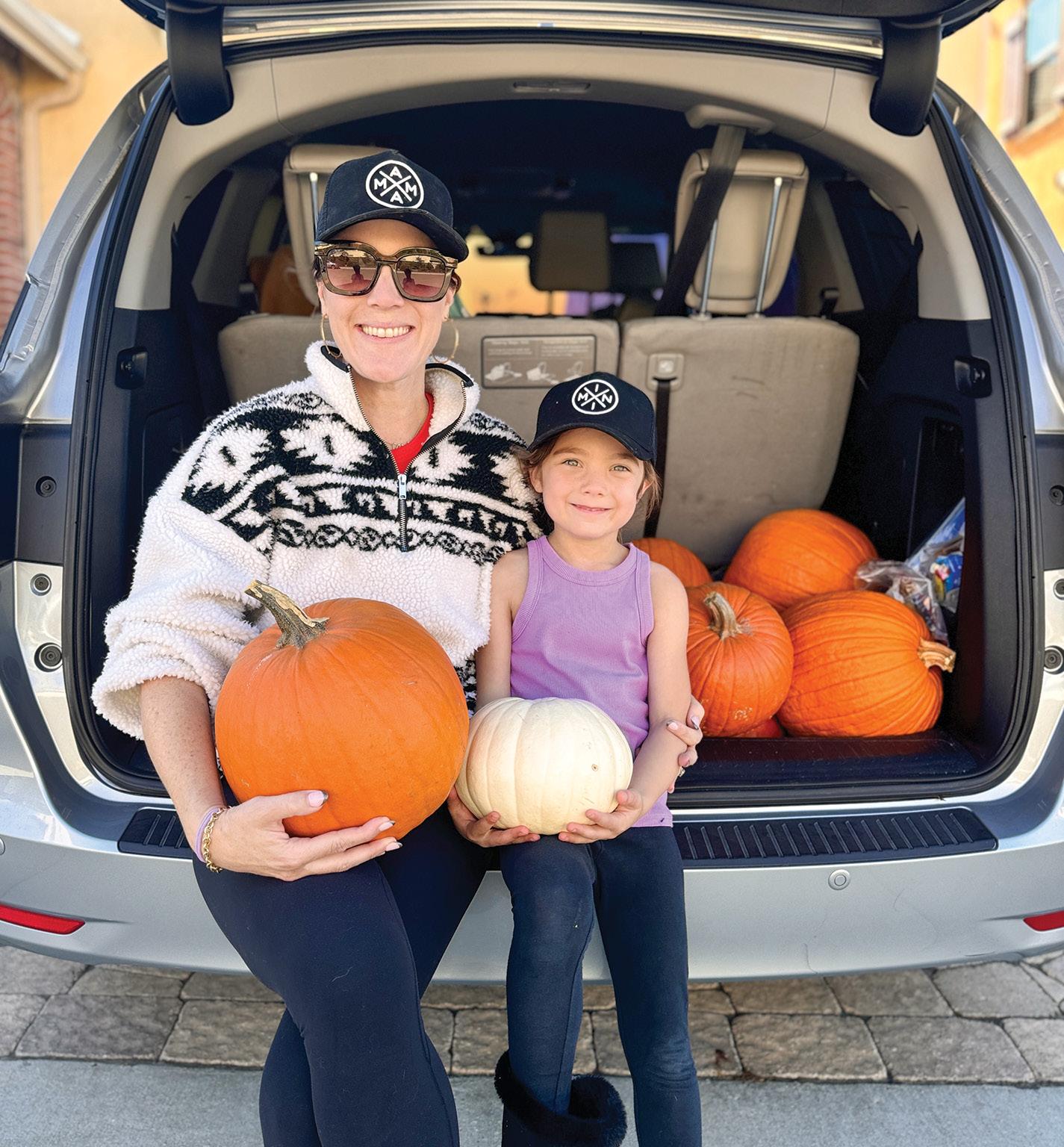


Top left: Lisa McGuigan and daughter Emma with their donations.
Top right: One of the 2024 beneficiaries enjoying a hearty pumpkin donation.
Photos courtesy Lisa McGuigan.
From Porch to Pasture: The 5th Annual Pumpkin Drive Turns Waste Into Hope
Every fall, more than 1.3 billion pounds of pumpkins are grown in the United States. Once the jack-o’-lanterns are extinguished and Halloween passes, most of these pumpkins are tossed into landfills, where they release methane gas—a harmful greenhouse emission far more potent than carbon dioxide. What begins as festive fall décor quickly becomes an environmental burden.
In the Temecula Valley, however, a growing tradition is rewriting this story. The Temecula Mama Pumpkin Drive, now in its fifth year, rescues thousands of pounds of pumpkins from landfills and delivers them to sanctuaries where they provide nourishment and enrichment for rescued farm animals.
This grassroots movement is led by Lisa McGuigan, creator of the popular Instagram account @TemeculaMama, which highlights family fun all over Southern California. What began as a lifestyle page has evolved into a platform for good— mobilizing a wide network of families to make a tangible impact.
“Last year alone, with the help of Sale Ranch Animal Sanctuary, we collected more than 5,000 pounds of pumpkins,” McGuigan explains. “This event not only provides vital nourishment for rescued animals but also unites our community in a powerful and meaningful way. Over the past five years, our collective efforts have diverted thousands of pounds of pumpkins from landfills, transforming potential waste into valuable enrichment for sanctuary animals across Southern California. We remain deeply grateful for the continued generosity of our compassionate community and for sanctuaries like Sale Ranch, who serve as steadfast champions for animals in need.”
The Pumpkin Drive is organized in partnership with Sale Ranch Animal Sanctuary, a refuge for farm animals discarded by the food industry. Beyond rescue work, Sale Ranch champions plant-based eating and regenerative gardening, reinvesting in the land and promoting a healthier food system. They also serve as part of a network of local farm sanctuaries, ensuring that the pumpkins collected are distributed widely throughout Southern California. A
HOW TO HELP
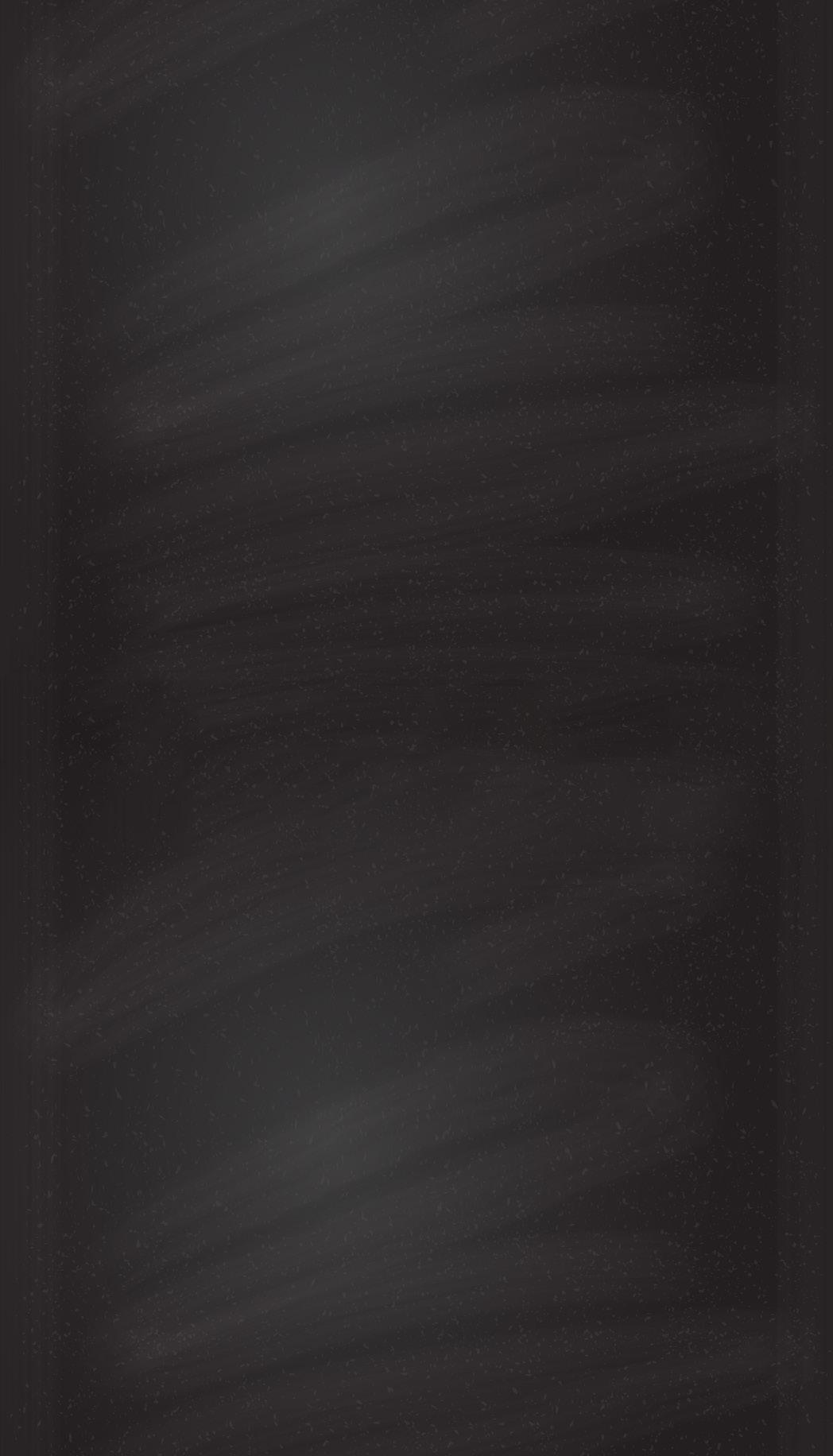
Pumpkin Drop-Off Locations
Bring your un-carved and un-painted pumpkins to one of the following locations between Nov. 1–3, 2025. All donations will benefit sanctuary animals throughout Southern California.
November 1, 8 a.m - 5 p.m.
Candace’s Pet Care Center 18885 Van Buren Blvd, Suite A5, Riverside
November 1, 9 a.m. – 2 p.m.
San Diego Children’s Discovery Museum 320 N. Broadway, Escondido, CA
November 1, 10 a.m. – 4 p.m.
AR Workshop Temecula
31795 Rancho California Rd. #500, Temecula, CA
November 2, 8 a.m. – 8 p.m.
Grocery Outlet
39573 Los Alamos Rd., Murrieta, CA
November 2, 11 a.m. – 6 p.m.
LUSH | Promenade Mall
40770 Winchester Rd, Suite 780, Temecula
November 3, 11 a.m. – 3 p.m.
Rancho Coastal Humane Society –
Vivian’s Learning Center
389 Requeza Street, Encinitas, CA
Curbside station directly in front of Vivian’s Learning Center at the shelter







Winning Our Case Then Celebrating: The Jewish High Holidays Explained
by Rabbi Yeruchem Eilfort
From Rosh Hashanah, the Jewish New Year, through Yom Kippur, the Day of Atonement, the Jewish people are in a time of judgement. We stand before the Almighty, and after taking a careful inventory of ourselves and our divine service, we beseech the Creator to forgive us for our sins. The climactic conclusion of the Yom Kippur service is called Ne’ilah, when the ‘gates of heaven’ are closed, and our judgement for the coming year is sealed.
No sooner do we leave the postYom Kippur break-the-fast that we begin preparing for the next step of the High Holiday observances, as we build a Sukkah. The Sukkah will serve as the
place where we will eat our meals and spend as much time as possible during the holiday of Sukkot.
The Sukkah is a temporary dwelling with detached branches serving as the roof. It is absolutely not impervious to the elements. The Sukkah represents the Clouds of Glory that accompanied the Children of Israel for their 40-year sojourn in the desert after leaving Egypt and before entering the Promised Land. Dwelling in the Sukkah represents our faith in Divine Protection, as we embrace the Divine Presence, known as the Shechinah, and it envelopes us.
There is another unique mitzvah/ commandment associated with this
holiday, which incidentally is also known as ‘Z’Man Simchatainu’ — the Time of Our Joy. We are commanded to take Arba Minim, the Four Species: a palm branch — Lulav; a citron — Etrog; two willow twigs — Aravot; and three myrtle twigs — Hadassim Each day of the holiday, other than Shabbat, we shake the Four Species three times in each direction while facing east: south (right), north (left), east (forward), up, down, west (backward).
Sukkot is rich with symbolism; from our envelopment within the Divine Presence to the unity of our people represented by the Four Species.
continues on page 33 >>


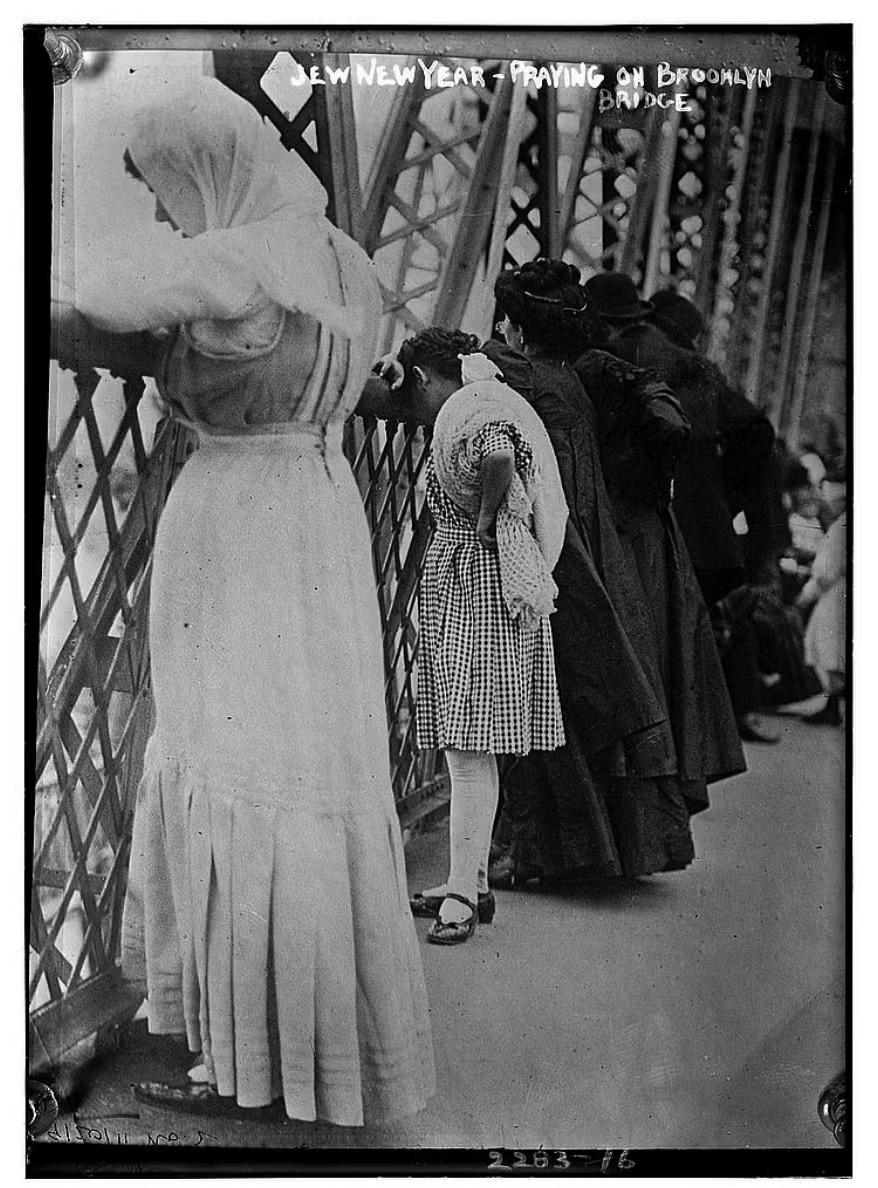
How New Yorkers Celebrated the High Holidays at the Turn of the 20th Century
by Jackie Hajdenberg, JTA News
In the fall of 1910, Edward Morgan, the Postmaster General of New York, made an impassioned plea to the city’s Jewish community: Send your High Holiday postcards early.
It was the height of the postcard craze in the United States, and members of the city’s Jewish community were eager to send well wishes to their loved ones for the Jewish new year. But the sheer volume of mail was a cause for concern.
“On account of the large quantity of letters and cards of greeting deposited in the General Post Office and Post Office Stations incidental to the Jewish Holy Days falling on October 4th, 5th and 13th,
this year, it is suggested that as much of this and other mail matter as possible be mailed on or before October 2nd, 3rd and 11th respectively, so that it may be handled and despatched [sic] before the Holy Days in question,” Morgan wrote in Der Morgen Zhurnal, one of the dozens of Yiddish newspapers in New York at the time.
Morgan’s plea is just one of the myriad stories that guides at the Tenement Museum are sharing this month as part of a limited series of walking tours on High Holidays past. The tours — which include a cooking demonstration led by culinary historian Sarah Lohman — explore
how Jewish families observed Rosh Hashanah and Yom Kippur back when the Lower East Side teemed with Jewish immigrants.
“This tour is based on all these primary sources that we found around how people celebrated the High Holidays in the turn of the century period, when this neighborhood was the largest Jewish community in the world,” said Kat Lloyd, vice president of programs and interpretation at the Tenement Museum.
The two-hour walking tour took participants through the apartment of Harris and Jenny Levine, the owners of
continues on next page >>
Left: Women pray on the Brooklyn Bridge during Rosh Hashanah, c. 1909. (George Grantham Bain, courtesy Library of Congress) Above: Rosh Hashanah cards from the turn of the century. (Via Wikimedia, Tenement Museum.)
Turn of the Century continued
a home-based garment factory who were expectant parents as Rosh Hashanah approached in the fall of 1892. Attendees also visit the home of Abraham and Fannie Rogarshevsky, immigrants from Lithuania who were employed in New York’s sweatshops.
The tenement apartments have been reimagined as they would look for the High Holidays. A round challah, for example, sits on the counter of the Levines’ kitchen, and a turn-of-thecentury ticket to High Holiday services is displayed in a glass case. Barely legible, the slip of moldy paper, which was discovered during a renovation of the museum, advertises Rosh Hashanah and Yom Kippur services at an Orchard Street synagogue.
The Tenement Museum has offered tours incorporating the Levine family apartment since the 1990s, though in recent years, digitization efforts and
High Holidays continued
new genealogical research have brought more information about the family to light, including the Yiddish names of Jenny and Harris: Shayndel and Hirsch. The new details about the Levines inspired the museum to create this special tour.
The walking tour begins outside the Tenement Museum (97 Orchard St.), where participants are asked to imagine Lower East Side’s bustling commercial activity ahead of the High Holiday season, with the streets full of pushcart vendors selling fruits, postcards and clothing. On a preview tour, Lloyd, who also served as a guide, asked us to picture how hundreds of thousands of mostly Eastern European Jews — or three-quarters of the 2.5 million Jews who immigrated to the United States between 1880 and 1920 — could possibly all fit in the area’s small, if numerous, synagogues. She explained how
Another potent symbol is recalled when we engage in a daily circling of the Torah reading table each day while holding our Arba Minim. The Talmud explains that this ritual represents us marching in victory, after the judgement of Rosh Hashanah and Yom Kippur.
Now perhaps we can better understand the flow of our calendar. We know that in the month of Elul, the month immediately preceding the time of judgement, we proactively work on improving ourselves. We address the miscues and mistakes of the past year. We make positive resolutions to strive to improve in the coming year. We then stand before G-d, plead our case, and accept Him as our King, reminding ourselves that He is also our loving Father. We end Yom Kippur on a note of confidence in a positive year ahead.
And then, without skipping a beat, we enter the Time of Our Joy, and we celebrate the virtual embrace we enjoy with our Creator. And then, on top of that, we grasp the symbol of victory in judgement, and march around triumphantly! No wonder Sukkot is called the Time of Our Joy!
Through our positive attitude coupled with a robust investment of energy we create a vessel into which we are confident that G-d will pour His blessings! This clearly demonstrates our confidence in the efficacy of positive thinking. Picture a positive outcome and that is what you will achieve.
saloons, movie theaters and storefronts were temporarily converted into congregational spaces during the most popular time of year for Jewish worship.
“The phenomenon was so widespread and well known that, within the community, they called it ‘mushroom synagogues’ for how fast they sprung in preparation for the High Holidays,” Lloyd said. “Any space could be transformed, which, I think, really underpins the solemnity and the intensity of the period.”
The tour concludes with a sweet treat: Lohman will bake a seasonal cake from Hinde Amhanitski’s 1901 Yiddish cookbook, “A Manual for Cooking and Baking” — the first cookbook published by a woman in Yiddish in the United States. A
May the Almighty bless each of us to be sealed in the Book of Life! A
Rabbi Yeruchem Eilfort co-directs, with his wife Rebbetzin Nechama Eilfort, Coastal Chabads, Chabad at La Costa, Encinitas, and Carlsbad North where everyone, regardless of level of knowledge or observance, feels cherished and loved. Rabbi Eilfort welcomes and encourages readers’ comments and questions sent to his personal email: rabbie@chabadatlacosta.com.

Jackie Hajdenberg writes for New York Jewish Week and JTA News.

It’s Always October
by Galia Miller Sprung
October. It’s always October. The month of surprise wars — The Yom Kippur War and now, Oct. 7. Two years since the invasion. October used to be a good month. My parents’ wedding anniversary was Oct. 7. The World Series. And my Aliyah anniversary. On Oct. 5, 1970, at 2:00 a.m., I landed in Lod, later Ben Gurion Airport. Easy calculation. It’s been 55 years. That’s what I was going to write about, but it doesn’t feel right. We are dealing with two years of loss, rockets, missiles, drones, sitting in bomb shelters or safe rooms, burials, shiva calls, yahrzeits, heroes, trauma, fear. Two years of words and pictures we cannot get out of our heads. And disappointment. Even anger sometimes. Not just mine — my friends’ too. We share our hurt and disbelief.
Not about antisemitism, although that’s everywhere. There is something more personal. It’s about the silence from people we thought would be there. The ones we thought would be the first to show concern on Oct. 7. Even on Oct. 8, or 9 or 10.
This is not political. In those first days, we were the number one news item worldwide. We were – still are — fighting an existential war. Over 300,000 reservists were called up. Thousands more fought for seats on airplanes to get back to Israel to join their units. We were all in imminent danger. There were 1,200 that had been slaughtered; 1,200 lives that connected to thousands more. It could have been the San Andreas Fault “Big One,” a hurricane in Miami, an epic disaster anywhere — a time when
you reach out to people you know in the danger zone. This disaster happened to be unimaginable horrors directed at the people of Israel.
From day one, friends — especially those we hadn’t heard from in years — found a way to get in touch. It was like a pep rally from those high school and college days. Only now there was support. Love. Caring. That’s all we needed. I treasured every text, phone call, social media message, private or public, even an emoji on a posting. Knowing that someone was taking the time to express their concern for our safety always boosted my spirits.
But we couldn’t ignore what wasn’t there. “Write about that,” a friend said recently. “About the absence of those we thought would be the first to check in.
“From day one, friends — especially those we hadn’t heard from in years — found a way to get in touch. It was like a pep rally from those high school and college days.”
Not out of politics, not out of ideology. Just out of friendship.”
It’s a sobering and painful moment when you realize those close friends really aren’t. There is residual hurt, but eventually, we continue without them while keeping in our hearts those who did reach out. Now that we are approaching the two-year mark, remembering the hurt is part of the personal reflection of 24 months of war we are all going through, whether we are aware of it or not.
There’s a balance we all seek — we all need. We have been living the war for two years. We stopped our lives for a very long time. The strange thing is, I don’t know how long that was. How long were there no ads on any TV channel? How long were the TV stations 100% news all day and all night? How long did we keep the TV on all day, waiting for more information, listening to interviews with survivors of the horrific attacks from the Nova, from kibbutzim and moshavim and towns of Sderot and Netivot and Ofakim? How long did we plan each outing to the market or doctor or shiva call or whatever took us away from our protected space? “Wear long pants for lying on the ground along the road.” How long were schools closed, activities canceled?
And then, unexpectedly, a promo on Kan 11 TV station: “‘Garlic, Pepper and Olive Oil’ is returning next Friday
evening!” The first non-news program. What does that mean? We’re going back to normal? The war is over? Of course not. Maybe like a “floater” to see the reaction to something normal. Regular programming. It was my birthday. I didn’t watch the show, and we didn’t celebrate even though it was one of those milestone birthdays. But looking back, I think starting with a culinary program was a good idea. Comfort food. No politics.
The producers were sensitive. They filmed the show at Danny’s Farm, a special therapeutic farm for combat injuries in Moshav Sitria, and dedicated a short spot each week to small business owners, who, like everyone else, were — and still are — struggling to keep their business going. And 18 months later, they are still filming there using the same format. Because we all love our soldiers and our food. And we put our favorite foods, the non-refrigerated comfort foods, in our safe rooms.
I didn’t mention the first Gulf War in 1991 because it was neither a surprise nor an October war, but it did require a stocked “sealed room.” Back then my daughters were in high school, and we kept a supply of fresh chocolate chip cookies in the sealed room. I don’t know how we ate them with gas masks on, but those cookies kept disappearing! This time, it’s just my husband and me. The safe room is still stocked, but we’ve
been pilfering the supply. Canned goods, crackers, tuna. Fortunately, we never needed any of it. We never stayed in long enough to need to eat. There is an art to the rockets and missiles and time needed in safe rooms. If the rockets are from the north or south, we’re usually out after ten minutes. From Iran, longer. First, the anticipation that ballistic missiles are on the way, wondering where our interceptors would “greet” them. Then waiting for all the huge chunks from the interception to descend from space. From Yemen? An annoyance. They rarely affect us. We turn to dark humor. I saw a YouTube comedy clip that sums up our situation: a missile alert sounds. The comedian, visibly annoyed, says, “I want to know where the missile is coming from before I wake up the kids!”
So, we joke and laugh and it’s October again. The war isn’t over. Alerts still sound. But I’m taking back October. I will celebrate my 55th Aliyah anniversary and focus on real friends, and the friends and soldiers we’ve all lost. I’ll kick the news habit and tune into the playoffs and the World Series instead. There’s nothing like the crack of the bat on a homerun pitch and the cracking of peanuts in the shell to revive the spirit. A

Sukkot is just around the corner! Widely known as a harvest holiday, it’s a time to share a meal with neighbors under the stars. Unlike other festivals, there are no specific foods that are eaten, but it is custom to eat foods that represent abundance, like stuffed foods and seasonal vegetables that can be shared and enjoyed outdoors. Every Sukkot, I made cabbage rolls, a hearty, warming dish that reminds me of dinners with my grandmother, Eva. This vegetarian version is packed with herbs, rich pine nuts and creamy white beans for a satisfying sukkot meal!
Note: You can freeze unbaked cabbage rolls. To cook, thaw them in the refrigerator for 30 to 45 minutes, and then bake per the recipe instructions. For even cooking, cover with foil.
BY MICAH SIVA
Dilly Rice Cabbage Rolls
MAKES 12-14 ROLLS, SERVES 6
INGREDIENTS:
Cabbage Rolls
• 1 tablespoon olive oil
• 1 medium yellow onion, finely chopped
• 6 garlic cloves, finely chopped
• 2 cups long grain rice, cooked
• 1 14-ounce can white cannellini beans, drained and rinsed
• 1 cup chopped fresh dill
• ½ cup toasted pine nuts
• ½ cup chopped fresh parsley
• 1 teaspoon lemon zest
• ½ cup sauerkraut, drained
• 1 large egg
• 1 large (or 2 small) green cabbage, stem trimmed
Sauce
• 1 28-ounce can crushed tomatoes
• 2 tablespoon apple cider vinegar
• 1 tablespoon granulated sugar or maple syrup
• ½ teaspoon garlic powder
• ½ teaspoon sea salt
• ½ teaspoon black pepper
To serve
• ½ cup sour cream, Greek yogurt, or labneh
PREPARATION:
Make the cabbage rolls
1. In a medium skillet over medium heat, heat the oil until it shimmers. Add the chopped onion and garlic, cooking for 6 to 8 minutes until softened.
2. Meanwhile, add the cooked rice, beans, drill, pine nuts, parsley, lemon zest and sauerkraut to a large bowl. Add the cooked onion and garlic mixture, mixing to combine. Season with salt and pepper to taste.
3. Add the egg and mix well.
4. Bring a large pot of water to simmer over medium heat. Add the cabbage and boil until the outer leaves are easily pulled off the core, 4 to 5 minutes. Set aside 14 to 16 leaves. If the cabbage leaves are still too difficult to peel off, add the cabbage back to the water to simmer for 4 to 5 minutes longer
Make the sauce
In a medium bowl, combine the crushed tomatoes, apple cider vinegar, maple syrup, garlic powder, salt and pepper.
Assemble the rolls
1. Preheat the oven to 350°F. Generously grease a 9-by-13-inch baking dish with olive oil.
2. Pour a thin layer of sauce on the bottom of the baking dish. Set aside.
3. Place 1 cabbage leaf in front of you, with the rib side facing up and smooth side down. If the cabbage rib is too large, trim it using a paring knife. Place a scant ⅓ cup of the rice and mixture 1 inch from the base of the leaf and roll it toward the top. Tuck the sides inward and roll up tightly. Set aside on a plate and repeat with all the cabbage leaves and filling. If some leaves break, roll two together to cover the holes.
4. Arrange the cabbage rolls in the baking dish in a single layer. Top with the remaining sauce. Cover with aluminum foil and bake for 75 to 90 minutes, or until the cabbage is tender.
5. Garnish with the chopped parsley, if desired, and serve with sour cream on the side.
Local Arts
BY EILEEN SONDAK

NORTH COAST REPERTORY THEATRE
northcoastrep.org
North Coast Repertory Theatre launched its 44th season with the world premiere of “Beside Myself,” directed by David Ellenstein. The hilarious and surreal story revolves around modern angst and focuses on a woman’s identity crisis, triggered by a medical procedure. Unfortunately, the show is set to close Oct. 5
Following on Oct. 22, is “Eisenhower: This Piece of Ground.” This San Diego premiere features John Rubenstein as Eisenhower, in a stunning performance. The powerful show will remain at NCR through Nov. 16
CYGNET THEATRE
cygnettheatre.com
Cygnet Theatre inaugurated its new home in Liberty Station with Stephen Sondheim’s “Follies,” a bittersweet examination of love and loss over the passage of time. Iconic Sondheim songs, including “Broadway Baby” and “Losing My Mind,” propel the plot in this Tony Award-winning musical, ensconced at The Joan. Extended through Oct. 19.
Cygnet’s second stage is raising the curtain on another must-see, “Vanya & Sonya & Masha & Spike,” by the acclaimed playwright Christopher Durang. Durang brings Chekhovian absurdity to a new level in this clever tale of modern family dysfunction. Chekhov might not recognize his brilliant comedy, but he’d have to admire the way Durang adapted the masterwork. You can see “Vanya…” Oct. 8 through Nov. 9.
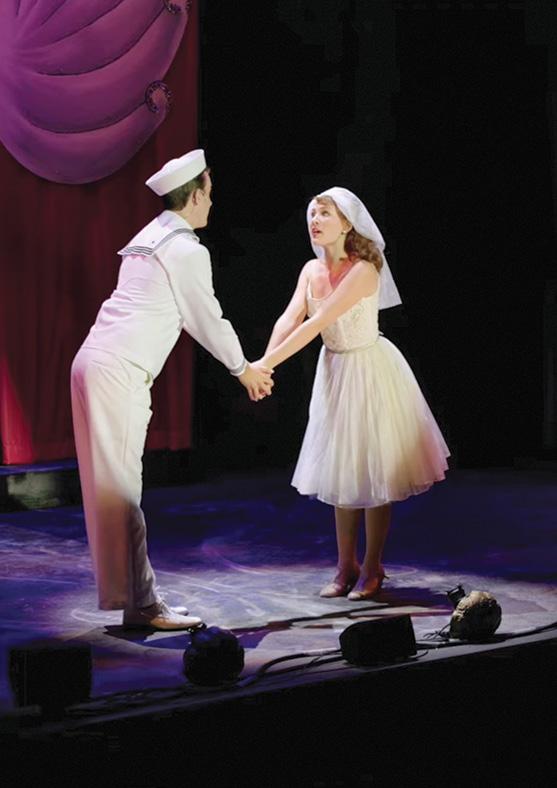
LA JOLLA PLAYHOUSE
lajollaplayhouse.org
La Jolla Playhouse continues to showcase “All the Men Who’ve Frightened Me” at the Mandell Weiss Forum. The story deals with a young married couple ready to start a family when they receive devastating news about the wife’s ability to carry a baby. Prepare to be surprised in this multi-layered drama which stays put through Oct. 12
The Playhouse’s Mandell Weiss Theatre will bring “Working Girl,” a world-premiere musical, on Oct. 28 The new musical is razor sharp and hilariously funny as it brings to life a secretary with big dreams. With a fresh book and new score by Cyndi Lauper, “Working Girl” promises to deliver an exhilarating theatrical experience. The show is directed by the Playhouse’s own Christopher Ashley. You have until Nov. 30 to check it out.

CYGNET THEATRE: “Follies.”
NORTH COAST REP: “Beside Myself.”
Photo by Aaron Rumley.
THE OLD GLOBE THEATRE
theoldglobe.org
The Old Globe is conjuring up the world of lords and ladies, wizards and dragons in its fascinating world premiere, “Huzzah,” playing on the Shiley Stage. This brand new musical is about two warring sisters who must come together to save their father’s Renaissance Faire from financial ruin. On stage through Oct. 19.
The Globe’s White Stage is featuring a West Coast premiere written and performed by Robert Montano. Titled “Small,” this autobiographical tour de force will give you a glimpse of life from the vantage point of a short kid from Long Island. The one-man show is about his remarkable career — from jockey to the Broadway stage. “Short” will be playing through Oct. 19
LAMB’S PLAYERS THEATRE
lambsplayers.org
The Lamb’s Players brings George Bernard Shaw’s masterpiece, “Arms and the Man,” back to local audiences after a long hiatus. The laugh-packed storyline focuses on a war-weary soldier who hides out in the bedroom of a beautiful young woman. What could possibly go wrong? The results are witty and highly amusing. Don’t miss this production, which runs through Nov. 16

MUSEUM OF CONTEMPORARY
ART SAN DIEGO
mcasd.org
The Museum of Contemporary Art San Diego has a stellar exhibition to show off — “Alex Katz: Theater and Dance,” a magnificent museum presentation of Katz’s work with the performing arts. The new exhibition demonstrates the way this talented artist’s work has been reflected across the full spectrum of dance and theater productions.
This is the first comprehensive exploration of Katz’s delightful and inventive collaborations with dancers and avant garde theater troupes over six decades. The show features about 90 rare archival materials, paintings and sketches. It turns the spotlight on 15 productions that Katz produced with the celebrated Paul Taylor Dance Co. That fruitful partnership produced some of the most important postmodern dances of the 20th century. The exhibition will stay on in La Jolla through Jan. 4, 2026
BROADWAY SAN DIEGO
broadwaysd.com
Coming our way courtesy of Broadway San Diego is “& Juliet,” which takes up residency at the Civic Theatre Oct. 14-19. The funny new musical is still knocking them dead on Broadway, but we have an opportunity to delight in a different take on the world’s greatest love story. It’s based on the premise that Juliet gets a second chance at life. Sounds like a winner!
SAN DIEGO JUNIOR THEATRE
juniortheatre.com
San Diego Junior Theatre has the beloved musical “Annie” waiting in the wings for an Oct. 24 opening The charming show has a timeless story of love, hope, and perseverance set against the backdrop of 1930s New York City. Take the family and enjoy before it closes on Nov. 9.
MUSEUM OF CONTEMPORARY ART: “Alex Katz: Theater and Dance.”
ADVICE
ASK MARNIE
by Marnie Macauley marniemacauley@gmail.com
Marnie’s New Year’s Resolutions
My dear San Diegans:
True, our New Year is different from “their” New Year. And while our resolutions are an inveterate part of our High Holidays, unlike the secular January 2nd, “I’ll lose 15 pounds this year,” we too could use some secular seykhel to have a strategically winning New Year.
As I’ve done in past New Years (Jewish and secular), I’ve chosen my favorite MOTS. (The only French word I know I can say in public.) These are the (forgive me) “life lessons” I’ve amassed after what seems like almost a century of living and developing the revolutionary Strategic Relationship Thinking (thesrtway.com) as a more effective way to manage life’s problems.
You won’t find these in 3x5 cutesy little books with posies on the cover. Never a posy person, and yes, with Jewish DNA coursing through my fingers, here are my “strategic resolutions” — for the quirky. You may need to sit.
STRATEGIC RESOLUTIONS
FOR LIVING
Strategic Resolution 1: Praise is like medicine. Too little won’t help and too much will kill you. Just right balances the compliment with proportionality and specificity, emphasizing determination.
Strategic Resolution 2: Common sense is critical, but
uncommon sense is unparalleled. Common Sense: “I have a right to be angry.” Uncommon Sense: “But I shouldn’t have snapped.” It’s the clarity that smart people wish they’d used five minutes earlier.
Strategic Resolution 3:
When your mate says, “I’m fine,” and doesn’t look it, listen to and react to the silence that follows. Noticing and reacting to what we notice is the greatest gift we can give our mates.
Strategic Resolution 4:
Breaks come to people who fail and fail again, and still move ahead seeing failure as their best teachers. It’s through failure that we see our errors, our possibilities, and it’s through determination that we see the light.
Strategic Resolution 5:
Criticism is a cutting tool, used by ragers and untalented reviewers. There is nothing that can’t be said or taught without having to slice your “victim’s” ego. There is no place nor reason for criticism among those you care for...and those you want to care for you.
Strategic Resolution 6:
Most relationships don’t die from conflict. They die from misread signals. Presuming you know what someone else means—when you don’t—is your Sword of Damocles. Don’t assume without sufficient proof in the real lane.
Strategic Resolution 7:
Absolute thinking limits truth. Optional thinking allows for truth. The ability to see with other lenses brings you closer to the reality of another person’s motives.
Strategic Resolution 8:
Over-reacting is being underinformed. Hyper-responding in the negative may mean your expectations are either unrealistic or incorrectly assessed. In either case, look to your own thinking to find the truth and avoid damaging blame.
Strategic Resolution 9:
Managing fear is far more do-able than conquering it. As fear/anxiety is the prime mover and root of our miseries, “conquering” all is an impossibility. Learn how to manage reactions to the anxieties and to move on.
Strategic Resolution 10:
Definition of a fool: When asked, “How much more do you want?” a fool replies, “Just a little bit more.” As there is always “a little bit more,” this “want” is both impossible and fraught with inherent frustration.
Strategic Resolution 11:
If you wish to be “the best” you will always suffer from feeling like “the least.” Given the fact that somewhere there is always someone who is “better” at whatever, your absolutism will doom you to the bottom rung.
Advice continued
Strategic Resolution 12:
Recognize anxiety as the root cause of your pain, but choose your reaction. We are born with primal anxiety. We can choose to exacerbate it or manage it comfortably.
Strategic Resolution 13:
In relationships as in life, chaos prevails if emotions eclipse strategy. Impulse in relationships can be deadly. Unless your impulse is to buy her Godiva, use your strategic uncommon sense when reacting.
Strategic Resolution 14:
Once in a while it’s wise to turn “No’s” into “Yeses” with young children— or anyone! Watch: “Mommy I wanna go to the park!” Instead of “No. You have to have lunch first,” try “You bet!” then quickly: “Right after you finish your PB&J.”
Strategic Resolution 15:
Passivity is a bromide for stagnancy. Think of the phrase “Feeling Better” as a combination action verb requiring positive action in word and deed—then reacting differently.
ABC STRATEGIES OF HEARING AND REACTING
Strategy 16:
The difference between listening and hearing is the difference between a nod and a knowing. Listening is a mere token on the road; hearing is your direction.
Strategy 17:
You don’t need to talk more. You need to decode faster.
Strategy 18:
The collapse didn’t start with the fight. It started with the missed cue.
Strategy 19:
Feelings don’t fix themselves. They escalate until someone strategizes.
Strategy 20 (Finale):
When it comes to AI receptionists asking you nothing about what you want, scream: Agent! Banker! Pharmacist! Doctor! Emergencyyyyyyyyyyyyyyy! (Someone out there is listening.) A
Marnie Macauley, MS, Columbia University –Creator of Strategic Relationship Thinking (an innovative way to solve problems), writer, editor, author, lecturer, clinician, and administrator – is a straight-shooter, with a distinctive voice and take on the world in her columns, features and books. She has been nominated for both an Emmy and a Writers Guild award.





Commercial Property Available
Beautiful downtown Vista has a 2000 sq.ft fully equipped 5 operatory Dental Office for rent. The complete building is also available for purchase, which has a 1100 sq.ft. space which is presently rented and has a lease. Total building is 3100 sq.ft. It also includes a spacious patio. For more information
call (760) 390-4171. Please leave a message if someone does not answer.
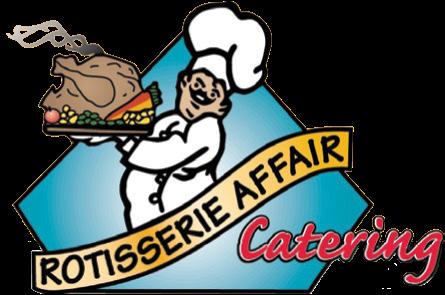

























Helene Shetzer – San Diego
Eva Greenberg – San Diego
Lillian Gerstman – San Diego
Elaine Matthews – San Diego
Kathleen Wachman – San Diego
Janet Davidi – Los Angeles
Esther Tishman – Poway
Charles Farbstein – La Jolla
David Geller – San Diego
Jerome Silverman – Carlsbad
Melvin Steig – Oceanside
Murray Hauser – San Diego
Lorraine Fish – Carlsbad
On behalf of

AM ISRAEL MORTUARY
We Are San Diego’s ONLY All-Jewish Mortuary Serving the community for over 40 years.
✡ Proudly Serving Jewish Families For Over 40 Years.
✡ Family Owned and Operated for Three Generations.
✡ Serving all Jewish Families, Orthodox, Conservative, Reform.
✡ Affiliated or Unaffiliated with a Synagogue.
✡ We can assist with At-need or Pre-need funeral planning. Purchasing cemetery plots or burial arrangements anywhere.
✡ We are here to help, call or email with any questions.
AM ISRAEL MORTUARY
We Are San Diego’s ONLY All-Jewish Mortuary Serving the community for over 40 years.
Last Word
COURTESY AMI ADAN COLLECTIVE



A Graphic Novel Remembers Oct. 7 Through Children’s Eyes
Two years after the Oct. 7 massacre, the headlines still echo with politics, strategy and conflict. What remains largely unheard are the voices of the children whose lives were shattered that day.
“Echoes of October,” a new graphic novel from the Ami Adan Collective, fills that silence. Told through the eyes of four children — from Tel Aviv, Gaza City, Toronto, and Daliyat al-Karmel — it presents the daily lives and shared humanity of young people before the attacks, not just the horror of that day.
“Echoes of October” uses the accessible medium of comics to spark
empathy and dialogue. Graphic novels have long carried history into classrooms and living rooms. Art Spiegelman’s “Maus” gave a generation its first intimate look at the Holocaust. Marjane Satrapi’s “Persepolis” revealed life inside revolutionary Iran.
“Graphic novels remain one of the most accessible ways to tell the hardest stories,” says Omri Rose, the project’s lead creator. “When children’s voices are ignored, history is distorted. This book insists that their voices matter.”
“Anniversaries are for memory,” says Omri Rose, the project’s lead writer. “But too often, memory is written by
politicians and generals. We wanted to create a work that remembers Oct. 7 from the ground up — from the eyes of those who carry loss but still crave life.” A
The Ami Adan Collective represents voices across divides — Jewish, Palestinian, Druze, and Canadian. Their collaboration aims to honor truth through storytelling rather than silence.


For more infomation, call 858-720-8250 or visit https://www.msmfamilylaw.com/attorneys/myra-chack-fleischer/ Legal Experts with Humanity






Founder Myra Chack Fleischer

